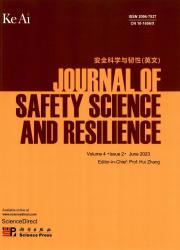JMoE-FAP: A novel model for telecom network fraud victimization pattern analysis
IF 3.4
Q1 PUBLIC, ENVIRONMENTAL & OCCUPATIONAL HEALTH
引用次数: 0
Abstract
A comprehensive examination of the victimization process, coupled with the development of effective preventive strategies, represents the most promising approach for mitigating telecom network fraud. However, the limited availability of telecom fraud case text data hinders the advancement of robust data extraction algorithms, thereby complicating the identification of victimization patterns. To address this gap, this study proposes a victimization process analysis model that leverages mixed expert event joint extraction, utilizing real telecom fraud case data. The model integrates LERT-MoE to extract trigger words and arguments related to the victimization process from law enforcement reports, followed by the application of a dot-product attention mechanism for argument role classification. To the best of our knowledge, this represents the first attempt to apply a mixture-of-experts model with a purpose-built dot-product attention mechanism for the in-depth analysis of telecom network fraud victimization patterns, overcoming the limitations of previous methods in managing the complexity and diversity of fraudulent behaviors. Additionally, the Apriori method is employed to uncover prevalent behavioral patterns in the victimization process. Experimental results demonstrate that the proposed model outperforms baseline models in precision, accuracy, and F1-score for event extraction tasks in telecom fraud instances. Furthermore, the model identifies more granular fraud patterns within the victimization process, offering a valuable knowledge base for the development of targeted preventive strategies. The identified patterns can be used to design focused awareness campaigns, enhance fraud detection algorithms, and improve law enforcement training, thereby significantly increasing the effectiveness of anti-fraud initiatives.
JMoE-FAP:电信网络诈骗受害模式分析的新模型
对受害过程进行全面审查,再加上制定有效的预防战略,是减轻电信网络欺诈的最有希望的方法。然而,电信诈骗案件文本数据的有限可用性阻碍了稳健数据提取算法的发展,从而使受害模式的识别复杂化。为了解决这一差距,本研究提出了一个受害过程分析模型,该模型利用混合专家事件联合提取,利用真实的电信欺诈案例数据。该模型集成了LERT-MoE,从执法报告中提取与受害过程相关的触发词和论点,然后应用点积注意机制进行论点角色分类。据我们所知,这是首次尝试将专家混合模型与专门构建的点积注意机制应用于电信网络欺诈受害模式的深入分析,克服了以前方法在管理欺诈行为的复杂性和多样性方面的局限性。此外,Apriori方法被用来揭示在受害过程中普遍存在的行为模式。实验结果表明,该模型在电信诈骗事件提取任务的精密度、准确度和f1分数上都优于基线模型。此外,该模型在受害过程中确定了更细粒度的欺诈模式,为制定有针对性的预防战略提供了宝贵的知识库。所确定的模式可用于设计重点突出的宣传活动、增强欺诈检测算法和改进执法培训,从而显著提高反欺诈举措的有效性。
本文章由计算机程序翻译,如有差异,请以英文原文为准。
求助全文
约1分钟内获得全文
求助全文
来源期刊

安全科学与韧性(英文)
Management Science and Operations Research, Safety, Risk, Reliability and Quality, Safety Research
CiteScore
8.70
自引率
0.00%
发文量
0
审稿时长
72 days
 求助内容:
求助内容: 应助结果提醒方式:
应助结果提醒方式:


